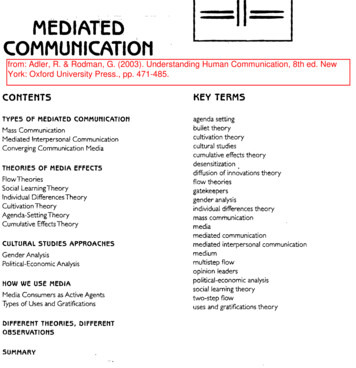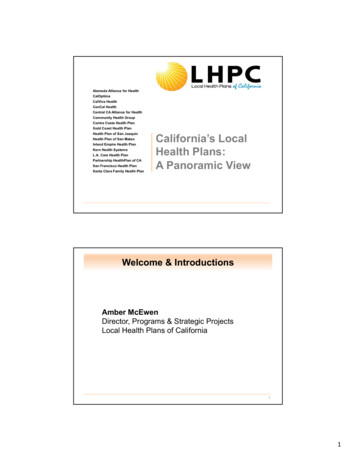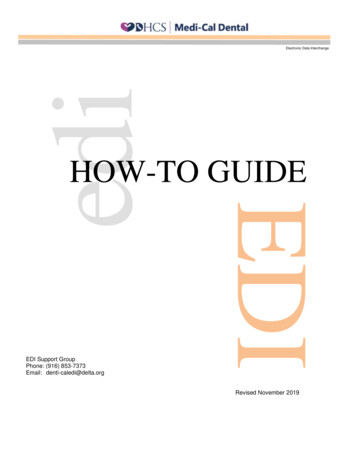
Transcription
MEDI:ATEDCOMMUNICATION---11-IIfrom: Adler, R. & Rodman, G. (2003). Understanding Human Communication, 8th ed. NewYork: Oxford University Press., pp. 471-485.CONTENTSKEY TERMSTYPES Of MEDIATED COMMUNICATIONagenda settingbullet theorycultivation theorycultural studiescumulative effects theorydesensitizationdiffusion of innovations theoryflow theoriesgatekeepersgender analysisindividual differences theorymass communicationmediamediated communicationmediated interpersonal communicationmediummuttistep flowopinion leaderspolitical-economic analysissocial learning theorytwo-step flowuses and gratifications theoryMass CommunicationMediated Interpersonal CommunicationConverging Communication MediaTHEORIES Of MEDIA EFFECTSFlow TheoriesSocial Learning TheoryIndividual Differences TheoryCultivation TheoryAgenda-Setting TheoryCumulative Effects TheoryCULTURAL STUDIES APPROACHESGender AnalysisPolitical-Economic AnalysisHOW WE USE MEDIAMedia Consumers as Active AgentsTypes of Uses and GratificationsDiffERENT THEORIES, DIFfERENTOBSERVATIONSSUMMARY
APPENDIX IIMEDIATED COMMUNICATIONsages will be constructed, and when they will be delivered. Sponsors, editors,producers, rep rters. and executives all have the power to influence massmessages.Because of these and other unique characteristics, the study of mass communication raises special issues and deserves special treatment.Mediated Interpersonal CommunicationAlthough the nature of mass communication is reasonably easy to understand,the characteristics of communication media aren't quite so easy to grasp'. Thefirst step is to define two terms. A communication medium is any device thatconveys a message. For example, radio is a communication medium, becausetechnology is used to bridge the distance between the sender and receivers.Mediated communication, then, is any type of communication in which messages are conveyed via some medium, rather than face to face. Because media isthe plura,! form of medium, we refer to the "print media" of books, magazines,and newspapers, the "broadcast media" of television and radio, the "entertainment media" of movies and recordings, and so on. In everyday use, the term media has taken on a second meaning, referring to the gatekeepers and decisionmakers in the mass media who determine what information will be conveyed tomass audiences and how it will be presented. For instance, in popular use wetalk about how "'the media" treat public figures such as politicians and celebrities and how "the media" address social issues like sex or violence.Mediated communication, however, doesn't involve just mass messages.Today, much interpersonal commurtication is also mediated. We speak to friendsover the telephone we e-mail friends and business contacts across the nationand around the world; we might even send a videotape to far-off relatives.Mediated interpersonal communication does not involve face-to-face contact(in a teleconference, you're talking to only a facsimile of that other face), but itcan possess all of the qualities of personal interaction described in Chapter 6.There are differences between mediated interpersonal communication andmass communication. In the interpersonal variety, a message doesn't go out to alarge audience, it isn't produced by professionals, and it allows a considerableamount of interaction and feedback.Converging Communication MediaThe distinction between mass and personal communication is much fuzzier today than in the past. In some respects, the World Wide Web resembles otherforms of mass media. Both individuals and organizations can create Web sitesthat have the potential to reach thousands, or even millions of computer users.Also, many Web sites are created by professionals and are quite elaborate in nature, including the "portals K of major corporations such as Microsoft, AOL-TimeWarner, and Yahoo!, which are part home page, part search engine. and partnews service.On the other hand, the Web also possesses characteristics of personal communication. Unlike most forms of mass communication, the Internet is a trulydemocratic medium: Anyone can set up a Web site and "broadcast" his or heropinions. Also, Web sites often invite visitors to submit queries and offer feedback via e-mail-just like a more personal medium.473I- CULTURAL IDIOM I.fuzzier: less dear
474APPENDIX IIMEDIATED COMMUNICATIONNewsgroups offer another example of how the Internet blends mass andpersonal communication. These groups are organized by and for people with aspecific interest. There are literally thousands of such groups, which address anastonishing range of topics. from antique cash registers to Lithuanian literatureto hip-hop music. After joining a newsgroup. members can post their own messages and read the messages of others. An e-group or listserv with a large number of members certainly has some qualities of mass communication, but it alsohas much of the feel of more personal interaction.THEORIES Of MEDIA EFFECTSThe media-whether mass, interpersonal, or convergent-are powerful forcesin society. Interestingly enough, the average person will say that society is certainly affected by the media but that he or she. personally, is not. Still, most people remain extremely interested in media effects and equally confused aboutthem. Do violent television and film cause violence in society? Does Internet usemake us depressed? Do print media contribute to the moral decline in society?The best answer to these and most other media effects questions is, "It depends." Several researchers have pointed out that this answer is not as ambiguous as it might sound:The answer «it depends" should not be met wirh despair and a throwing up of rhehands, however. The answer "it depends" does not mean that we do not know what isgoing on. In contrast to what we knew 40 or 50 years ago, we now have so e moredefinite ideas of what "it" depends on. 1A quick look at some key theories will help explain the effects that media haveboth on societies and the people who compose those societies. Although thesetheories were all originally posed as theories of mass communication, they havebeen increaSingly applied to interpersonal and converging media in recent research. lflow TheoriesSome of the earliest theories of media effects, flow theories, dealt mainly withthe way effects traveled, or "flowed," from the mass media to their audiences.BULLET THEORV Early mass media researchers, those who worked between thefirst and the second world wars, developed an approach later termed bullet theory, which implied that the media had direct, powerful effects-like a bullet. 3According to bullet theory, people who watched violent movies, for example,would become violent, and those who read "immoral" comic books would become immoral. The problem was that these direct, powerful effects were verydifficult to prove, especially over the long term. Eventually, a different theoretical model evolved.TWO-STEP FLOW THEORY'" Research during and after World War II suggestedthat media effects occurred in a two-step flow, meaning that media effects occurred mostly in interaction with interpersonal communication. Researcherscharacterized two-step flow like this: People would hear a message over the radio, perhaps a speech by a political candidate or a commercial message for a
APPENDIX IIMEDIATED COMMUNICATIONnew type of laundry soap. Rather than immediately pledging their support forthe candidate or buying the soap, they would discuss it with opinion leaderspeople they knew whom they viewed as credible sources of information ori "aparticular topic. If the opinion leaders were positive about the candidate orproduct, the people who heard the original message might becomesupporters of it.The researchers who devised the two-step flow theory weremoving in the correct direction-they just hadn't gone far enough. Today's researchers recognize a multistep flow, which implies that media effects are partof a complex interaqion." In that interaction, opinion leaders have opinionleaders, who in turn have their own opinion leaders. You might be your friend'sopinion leader about what sort of computer to buy, for xample, but that friendprobably formed his or her own opinions from other people.Besides demonstrating how theories become more soph sticated as they areexplored over time. flow theories demonstrate the ,importance of interpersonalcommunication in the effects of mass communication. They show that the massmedia don't operate on us in a vacuum: Rather, their effects are tempered by theway people react to them and communicate their reactions to one another. Also,even though the bullet theory is largely discredited today, we still have daily examples of some types of mediated messages having the direct, powerful effectsthat early researchers predicted. Many products become overnight successesthrough television advertising, without enough time passing to give interpersonal communication much time to operate. A new blockbuster movie, for example, can earn tens of millions of dollars in box office receipts in its first weekend, based purely on advertising and reviews that appeared in the mass media.But for the great majority of mediated messages, effects depend largely on howthey interact with interpersonal communication. After the first weekend that amovie is in the theaters, its box office is determined largely by "word of mouth"communication.MULTISTEP FLOWSocial learning TheoryFlow theories aren't the only approach to studying media effects. Social learning theory is based on the assumption that people learn how to behave by observing others-often others portrayed in the mass media. The theory gainedprominence from the experiments of Albert Bandura in the 19605. 5 In Bandura'smost famous studies, preschool children watched films in which an adult encountered Bobo, a three-foot-tall pop-up clown. One group of preschoolers sawa version in which the adult beat up Bobo and was then rewarded for being a"strong champion." Another group saw a version in which the adult assailantwas scolded for being a bully and was spanked with a rolled-up magazine. Afterwatching the films, the children themselves then had a chance to "play" withBobo. Bandura discovered that the children who saw the adult model's aggression being rewarded treated the Bobo doll more Violently than did those whosaw the adult model punished.The implications of social modeling are obvious. It's easy to imagine how athirteen-year-old who has just seen one of the Lethal Weapon or Terminatormovies might be inspired to lash out at one of his friends the first time a disagreement arises. However, the theory also suggests that viewing prosocial models can teach constructive behavior. The same thirteen-year-old, if he had just475ICUlrURAL IDIO I. op rate in avacuuinffunction as ifthere were no otherindividuals or influencesto lash out to reactangri at:
476APPENDIX IIMEDIATED COMMUNICATIONwatched Friends, might be inspired to use one of those characters' nonviolent,communicative approaches to problem solving rather than using his fists.Social learning theory makes sense, and the original laboratory studies produced impressive results. But in everyday life the theory doesn't hold up quiteso welL 6 After all, behavior that is modeled from the media might not be successful in the real world. For example, thirteen-year-olds who tryout theirmartial arts skills on the playground might be punched in the nose by tougheradversaries. The pain of that punch might do more in determining thosechildren's attitude toward violence than all the television viewing they willever do.Besides the power of real-life rewards and punishments, all individuals aredifferent, and that plays a role in determining how people are influenced by media. For example, boys seem to be more influenced by violent media than girlsare, whereas girls seem to be more influenced by the "body image" of their media models-they often try to be as slim as fashion models, an influence thatgenerally escapes boys. Observations such as these led to the development ofthe individual differences theory:Individual Differences TheoryAs its name suggests, individual differences theory looks at how media users,with'different characteristics are affected in different ways by the mass media. 7Some types of users are more susceptible to some types of media messages thanare others. For example, a viewer with a high level of education might be' moresusceptible to a message that includes logical appeals. Besides level of education, individual differences that help determine how the media affect individualsinclude age, sex, region, intellectual level, socioeconomic class, level of violencein the home, and a wealth of other characteristics that were referred to as demographics in Chapter 10.There are also more subtle psychological"characteristics that distinguish media users. Diffusion of innovations theory, for example. explains that there arefive types of people who have different levels of willingness to accept new ideasfrom the media. s These types also predict who will be first to use and becomecompetent in new media. 91. Innovators-These are venturesome people who are eager to try new ideas.They tend to be extroverts and politically liberal. They are the first to try outand become competent in new media like the World Wide Web and newcomputer applications.2. Early adopterS-less venturesome than innovators, these people still make arelatively quick but informed choice. This tendency makes them importantopinion leaders within their social groups.3. Early majority-These people make careful, deliberate choices after frequentinteraction with their peers and with their opinion leaders. They seldom actas opinion leaders themselves, however.4. Late majority-These pepple tend to be skeptical and accept innovationsless often. When they do adopt an innovation, they often do so out of economic necessity or increasing peer pressure.5. Laggards-These people tend to be conservative, traditional, and the mostresistant to any type of change. Their point of reference tends to be the past,
APPENDIX IIMEDIATED COMMUNICATIONand they tend to be socially isolated. Today, these are the people who aremystified by the World Wide Web and might not even own a computer.Cultivation TheoryAccording to cultivation theory, the media shape how we view the world. 10Cultivation theory therefore works hand in hand with the facets of perceptiondiscussed in Chapter 2. This theory helps explain how a person's perceptions ofthe world are shaped and sometimes distorted by media.Cultivation theory was advanced by George Gerbner and his associates at theUniversity of Pennsylvania. This theory predicts that media will teach a common worldview, common roles, and common values. Over time, media "cultivates" a particular view of the world within users. For example, Gerbner'sresearch found that heavy television viewers had a markedly different view of reality than did light viewers. Heavy viewers overestimated their chances of beinginvolved in some type of violence, overestimated the percentage of Americanswho have jobs in law enforcement, and found people, in general, to be lesstrustworthy than did light viewers.Cultivation theory suggests that the primary effect of televiSion, therefore, isto give heavy viewers a perception that the world is less safe and trustworthy,and more violent, than it really is. Gerbner's findings help explain why societyseems to be becoming more tolerant of violence, a process that is known as desensitization. Researchers suspect that desensitization has a profound effect oninterpersonal communieation by making people less caring about the feelingsand reactions of other people.Agenda-Setting TheoryAnother important approach to media effects was posited by two researchers,Donald Shaw and Maxwell McCombs. in the 1970s. Studying the way politicalcampaigns were covered in the media, Shaw and McCombs found the main effect of media to be agenda setting: The media tell people not what to think, butrather what to think about. In other words. the amount of attention given to anissue in the media affects the level of importance aSSigned to that issue by consumers of mass media. Shaw and McCombs explained their findings as follows:Perhaps more than any other aspect of OUf environment, the political arena-allthose issues and persons about whom we hold opinions and knowledge-iS secondhand reality: Especially in national politics, we have little personal or direct contact.Our knowledge comes primarily from the mass media. For the most part, we knowonly those aspects of national politicS considered newsworthy enough for transmission through the mass media. 11The main thrust of agenda-setting theory is that the media might not changeyour point of view about a particular issue, but they will change your perceptionof what's important. 12 Although Shaw and McCombs concentrated on politicalissues and the news media, the idea of agenda setting can easily be expanded toall issues and [0 all the media. For many people, if a social problem is not on television, in the newspapers, or on a Web site, it may not exist-at least in theminds of media users. For today's researchers, the important point to make477
478APPENDIX IIMEDIATED COMMUNICATIONabout agenda setting is that after issues get attention from the public they have atendency to influence government policy: 1.3Cumulative Effects TheoryNot everyone agrees with the agenda-setting theory: Some point out that the media do, indeed, tell us what to think, but they do it slowly, over time. This hascome to be called cumulative effects theory, which states that media messagesare driven home through redundancy and have profound effects over time.According to this theory, the media latch on to certain themes and messages and build them up over time. There is a bandwagon effect as variousnewspapers, magazines, television and radio networks, and other media takeup the themes. Because the media are omnipresent and such a common partof most people's lives, the media view becomes the widely accepted onewithin society.According to this theory, a "spiral of silence" occurs when individuals withdivergent views become reluctant to challenge the consensus offered by the media. People form unconscious perceptions of the distribution of public opinion.If they feel that they are in the minority, they are less likely to express their opinions. People who hold majority viewpoints tend to speak out confidently. Forexample, in times of war some people might become concerned about civiliancasualties inflicted on the other side, but they don't speak out about this issue ifthey feel that most people disagree.CULTURAL STUDIES APPROACHESAll the theories we have discussed so far stress the media's effeCt on individuals;but these same media appear to have significant long-term effects on entire cultures. The role that the media play in changing us as a society is difficult tomeasure. Rather than rely on statistical analyses and controlled experiments,cultural studies rely on "'close reading" of messages from the mass media.Media critics examine the meanings of these messages, both surface and hidden,and then use logic and insight to come to certain conclusions about the effectthose messages might have on their audiences. Cultural studies examine the rolethat media play in reflecting and shaping society's most Widely and deeply heldvalues in areas such as class, race, and gender.Cultural theorists explore the invisible ideology, or belief system, that isembodied in media programming and use. They ask questions about the nature of masculinity, femininity, individualism, capitalist economics, and education, among other topics. Does a television program affirm a particularlifestyle as natural? Does a movie advance a preferred way of viewing theworld? Does an ad campaign make a statement about social roles? If a particular worldview is being advanced, who is being served by this view? In short,what meanings does this mediated message present? Some cultural theoristsabandon the goal of impartiality that characterizes the social sciences, criticizing some social practices 'and suggesting what they believe are better alternatives.There is a wide range of cultural approaches, including (but not limited to)political-economic analysis and gender analysis.
APPENDIX IIMEDIATED COMMUNICATIONGender AnalysisGender analysis examines how the media construct and perpetuate gender roles:"Our culture's assumptions about how males and females should think act, andspeak are continually presented in our mediated messages. The potential influence of these gender portrayals on our sense of who we are and who we should beis the gender critic's realm of consideration. These studies are concerned with theways that gender stereotypes are confirmed and contradicted and with the waymedia legitimate the language we use to describe gender and sex roles.For example, Caren Deming and Mercilee Jenkins examined the gender rolesthat were advanced in the classic television sitcom Cheers. 14 Their method was aclose reading of just one episode of the series, which happened to be the premiere. These researchers found that the show contradicted certain genderstereotypes through dialogue and visual imagery. Their study showed how thecharacter Diane Chambers (played by Shelley Long) used humor as a tool of resistance and succeeded in asserting her individuality in the face of attempteddomination. Deming and Jenkins demonstrated how a sitcom like Cheers can refute the rules that subjugate people and therefore have a liberating effect on itsaudience.Several other gender theorists have looked at the effects of media. CherisKramarae proposes a "Muted Group" theory. which she explains as follows:The language of a particular culture does not serve all its speakers equally, for not allspeakers contribute in an equal fashion to its formulation. Women (and members ofother subordinate groups) are not as free or as able as men are to say what they wish,when and where they wish, because the words and the norms for their use have beenformulated by the dominant group, men. 15 .Kramarae examines the media to see how language is "man-made" and how it"aids in defining, depreciating and excluding women, 116 Another feministscholar, Carol Gilligan, presents a theory that men and women speak in differentethical voices,17 Her "Different Voice" theory posits that men define moral maturity in terms of justice, whereas women define it in terms of caring. Researcherswho follow Gilligan's thinking look at mediated messages to see how those messages encourage these different voices. ISPolitical-Economic AnalysisMuch of today's political-economic analysis is based on the work of the philosopher Karl Marx 0818-1883), To Marxist media critics, Marx was a humanistwhose argument was essentially a moral one. Marx believed that the economicsystem of a nation (in the case of the United States, capitalism) influences thevalues of the entire culture (in our case, encouraging materialism, which is thecraving for money and what it can buy). Political-economic analysis is a critical technique that focuses on the media's role in this influence. It looks at howmedia become the means by which the haves of society gain the willing supportof the have-nots to maintain the status quo,Marxist critics believe that media help create a "false consciousness" withinthe working/consuming class that enables the wealthy, who benefit most fromthe social arrangements in a capitalist country, to manipulate and exploit theworking/consuming class. One expert on this type of analysis summed it up inthis way:479
480APPENDIX IIMEDIATED COMMUNICATIONThe most frequent theme in Marxist cultural criticism is the way the prevalent modeof production and ideology of the ruling class in any society dominate every phase ofculture, and at present, the way capitalist production and ideology dominateAmerican culture, along with that of the rest of the world that American business andculture have colonized. 19According to Marxist theory, workers in a capitalist society are kept in a constant state of dissatisfaction. To escape from this dissatisfaction (which they donot recognize as a condition, but the symptoms of which they feel), they engagein various forms of consumption, all of which cost money, so that they areforced to work increasingly hard to escape from the effects of their work. Thedissatisfaction generated by a capitalist system is therefore functional, because itencourages the impulsive consumption that enables capitalism to thrive.In a Marxist analysis, the mass media perfonn the function of distracting peoplef om the realities of their society (poverty, racism, sexism, and so on) by "cloudingtheir minds" with the ideas that powerful commercial forces want them to have,ideas like "I feel better when I buy something.» By doing so, the' media perfonn thefunction of maintaining the dominance of those already in positions of power.Marxist theory has led to many interesting inSights about mass media. For example, two researchers looking at Muzak, the type of instrumental music wehear in elevators and department stores, pointed out that this type of "functionalmusic," which was originally used in factories to control and regulate work, isnow used in stores and malls to control and regulate consumption. 20One of the best-known political-economic critics is Stuart Hall. Hall's workattacks "the unknowing acquiescence to the" dominant ideology of the culture"21and urges resistance to that acquiescence. He seeks to raise consciousness aboutthe media's role. Hall does not claim a widespread establishment conspiracy tooppress the poor and the powerless; he accepts this oppres:sion as a seldomrecognized part of the economic system of both the country and the media. Inrecent years, his work has sought to bring together various forms of culturalcriticism, saying that gender, semiotics, and political economy are all part of the"representations" of the media. and that those representations are what producethe medias overall effect. 22HOW WE USE MEDIAAll of the theories we have explored so far have characterized media consumersas passive being acted upon by various types of media, their content, and theircreators. But instead of analyzing media effects, another group of scholars hasdeveloped uses and gratifications theory: the study of ways in which mediaconsumers actively choose and use media to meet their own needs.:13 Uses andgratifications research doesn't regard consumers as passive creatures whose behaviors are controlled by the media industry. Instead, it regards them as decisionmakers who choose-sometimes consciously and sometimes less consciouslywhich media to use and how to use them.Media Consumers as Active AgentsThe difference between a uses and gratifications perspective and the other perspectives we have explored so far becomes clearer when we look at how eachmight explore a media phenomenon such as professional wrestling. Millions of
APPENDIX 1/people are devoted followers of this pseudosport. Media effects researchers con·cerned with violent behavior might study the relationship between watchingwrestling and being aggressive. For example, they might study whether'wrestling fans get in more fistfights or whether they are more likely to act violently toward their spouses or children, If researchers did discover a link between watching wrestling and perpetrating physical violence, they would try tosort out the causal relationship between the two phenomena: whether for example wrestling causes people to behave more violently, or whether people withviolent personalities are attracted to wrestling. Cultural studies scholars mightanalyze how wrestling perpetuates violence in culture. how the wrestlers andtheir fans are explOited by corporate interests, or how the sport contributes to amale-dominated society.By contrast, a uses and gratifications approach to wrestling would not concern itself with the effects of viewing the sport. Instead it would explore whatmotivates fans to watch wrestling in the first place and what needs wrestlingfans are sa,tisfying by watching matches. A uses and gratifications approach underscores the active role of media consumers. It regards them as decision makers rather than puppets who are driven by unconscious forces or manipulatedby media producers.Unless you are a wrestling fan yourself. you might wonder why anyone wouldwatch more than a few minutes of this obviously phony "sport.» A uses and gratifications perspective offers some answers to this question. Depending on their interests and attitudes. viewers might tune in to a match for a number of reasons.One reason might be excitement: Gullible viewers might find ex itement, wondering which valiant combatant will win the contest. A second reason might beamusement: More sophisticated fans might watch the over-the-top costumes.names, and mock aggression as a joke instead of a genuine athletic event. A thirdmight be catharsis: Watching muscular brutes slam one another to the canvasmight be a better way of letting off steam than yelling at the family or kicking thecat. A fourth reason might be escape: For some fans, a wrestling match might bejust the way to forget about the problems and challenges of the real world.If you smugly dismissed the thought of watching phony wrestling for any reason. consider the fact that you probably c onsume other types of media for thesame sorts of motives. Do you read novels? Surf the Web? Listen to sporting-events on the radio or watch them on TV? Tune in to dramas or comedies?Watch films? If so, a little reflection will probably reveal that your reasons forconsuming each type of media probably resemble some of the ones in the preceding list about wrestling.Our brief look at professional wrestling should help you see the dif
theories were all originally posed as theories of mass communication, they have been increaSingly applied to interpersonal and converging media in recent re search. l . flow Theories . Some of the earliest theories of media effects, flow theories, dealt mainly with the way effects traveled, or "flowed,"










